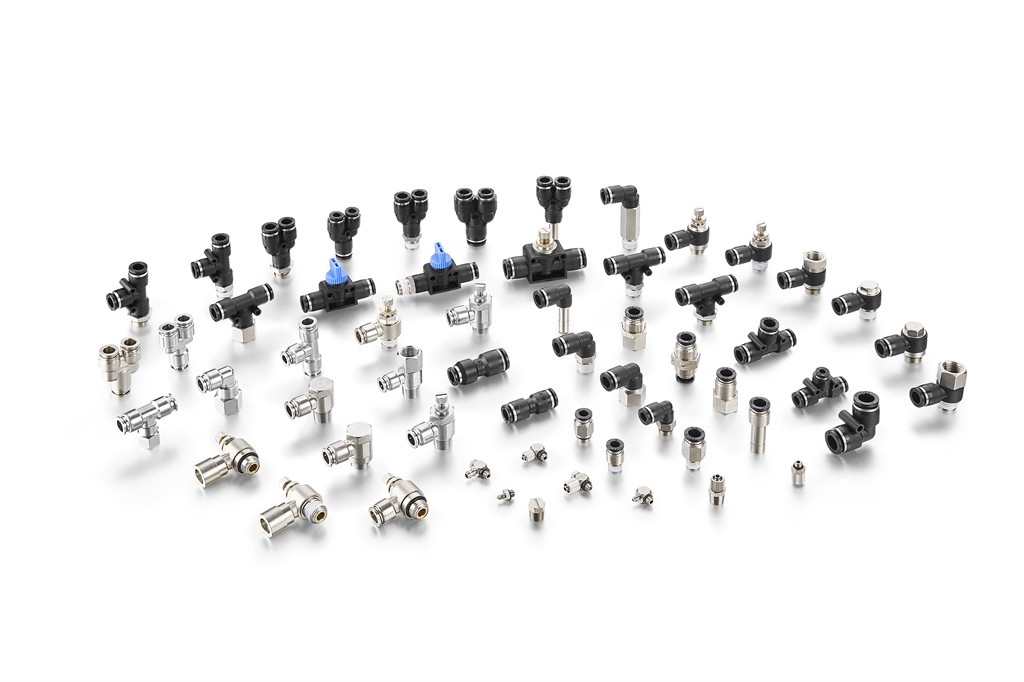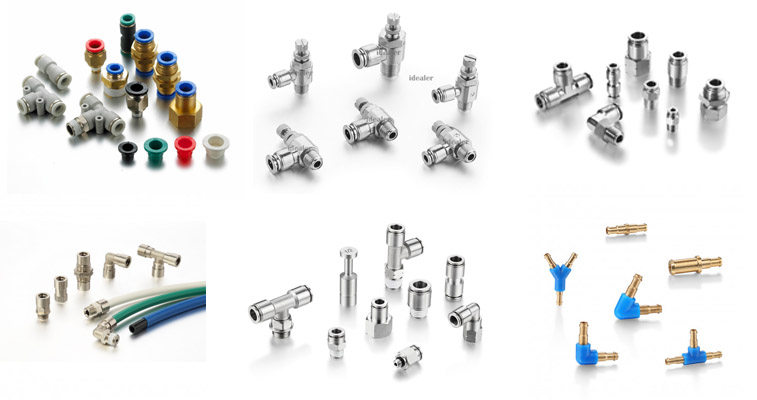Pneumatic fittings seem simple until they fail in the field—then they become the most expensive part in your system. Choosing the right material is the fastest way to prevent leaks, corrosion, and downtime. Chinese pneumatic manufacturers offer strong coverage across brass, nickel‑plated brass, stainless steel (304/316), and engineered plastics (PBT/PA composites), but each material fits a specific window of media, pressure, and environment.
Use brass for general indoor, dry compressed air with moderate pressures; nickel‑plated brass when you expect intermittent moisture or mild corrosive atmospheres; 316 stainless steel for sustained moisture, chlorides, washdown, food/pharma, and aggressive gases; plastics/composites for lightweight, low‑pressure, indoor circuits with compatible chemicals. Always verify thread standards (BSPT/NPT), sealing elastomers, and material certificates before mass orders.
In this guide, we’ll map materials to applications, compare cost vs. corrosion resistance, explain certification and verification options, and show how material choice affects MOQs and lead times when sourcing pneumatic components from China. We’ll also cover common hubs like Ningbo, Yuhuan, Dongguan and what to expect on tooling, plating, and inspection.

Table of Contents
ToggleHow to Match Fitting Material to Your Media, Pressure, and Environment
Selecting material starts with three variables: what’s flowing (media), the mechanical load (pressure/temperature/vibration), and the environment (humidity, washdown, chemicals, UV). Get those right and sourcing becomes straightforward.
Map material to risk. Brass suits clean, dry air indoors; nickel‑plated brass extends into mildly corrosive or damp settings; 316 stainless covers harsh environments and hygiene-critical zones; plastics handle low-pressure, indoor circuits with the right chemical compatibility.
Media and Chemical Compatibility
- Dry compressed air: Brass or nickel‑plated brass are typical; plastics if low pressure and indoor.
- Moist air/condensate: Nickel‑plated brass or stainless; avoid unplated brass where moisture is sustained.
- Chlorides, saline mist, washdown, marine: 316/316L stainless; avoid brass and often 304 in heavy chlorides.
- Ammonia, amines: Avoid brass due to stress-corrosion cracking potential; choose 316 stainless.
- Hydrocarbons/solvents: Check compatibility tables for seal and plastic body materials; stainless steel bodies with FKM/FPM seals are common.
- Food, pharma, cleanroom: 316/316L stainless with appropriate seals; verify surface finish, cleaning protocols, and conformity to hygienic requirements.
Pressure and Temperature Window
- Typical industrial pneumatics (0–10 bar / 0–145 psi): Brass, nickel‑plated brass, and plastics (PBT/PA composites) are common.
- Higher pressure (>16 bar) or pulsation/vibration: Prefer stainless steel (or robust brass if environment is non-corrosive).
- Temperature extremes: Stainless steel tolerates heat best; plastics are limited (often −20 to 60°C). Consider seal selection (NBR vs. FKM vs. EPDM) alongside body material.
Mechanical and Installation Factors
- Frequent connect/disconnect or high torque on threads: Metals (brass or stainless). Plastic threads can creep or crack.
- Weight-sensitive designs: Plastics or composite bodies with metal threads.
- Aesthetics and surface stability: Nickel‑plated brass resists tarnish and provides a hard wearing surface.
Pro Tip: Specify both the body material and the seal material on your PO. A stainless body with NBR seals may still fail in steam or strong solvents; match elastomers to media.
Cost vs. Corrosion Resistance: Practical Trade-offs for Industrial Fittings
Budget and lifetime cost often pull in different directions. Here’s how we help buyers balance the equation.
If exposure to moisture, chlorides, or chemicals is continuous or critical, stainless steel’s higher upfront cost is usually cheaper over the life of the machine. For controlled, indoor air systems, brass or nickel‑plated brass deliver the best cost-performance.
Material Comparison at a Glance
| Material Type | Typical Application | Pros | Considerations |
|---|---|---|---|
| Brass | Indoor, dry compressed air lines, manifolds | Low cost, easy machining, wide availability | Avoid ammonia/chlorides; surface tarnish |
| Nickel‑Plated Brass | Mildly corrosive or damp environments | Better corrosion and wear than brass | Plating must be uniform; inspect for pinholes |
| Stainless Steel (316) | Food/pharma, marine, washdown, aggressive gases | Excellent corrosion resistance, hygiene | Highest cost, longer machining time |
| Plastic/Composite (PBT/PA) | Lightweight, low-pressure, indoor circuits | Low cost, light, fast assembly | Limited pressure/temperature, thread strength |
Realistic Cost Signals
- Unit price tiers (indicative, varies by size/spec): Plastic < Brass ≈ Nickel‑plated brass (slightly higher due to plating) < Stainless steel.
- Process cost drivers: Machining complexity, plating steps, raw material volatility (nickel, molybdenum), and inspection requirements.
- Lifecycle view: If you expect washdown, brine mist, or caustics more than “occasionally,” stainless typically outperforms brass on total cost of ownership.
Caution: Low-cost fittings may use recycled brass with higher lead or porosity, increasing leakage risk and reducing corrosion resistance. Ask for material certificates and pressure/leak test reports.
Where Each Material Works Best (With Do’s and Don’ts)
Engineers often ask us for a quick decision matrix. Use this as a field guide.
Choose stainless for sustained moisture or hygiene; nickel‑plated brass for intermittent moisture; brass for indoor dry air; plastic for low-pressure indoor systems where weight and speed matter.
Brass
- Use: General industrial air lines, manifolds, solenoid valve ports, instrument air in non-corrosive indoor environments.
- Avoid: Ammonia service, high chloride exposure, outdoor marine atmospheres, continuous condensate.
- Seal pairing: NBR for standard air; FKM where oils/temperature are higher.
Nickel‑Plated Brass
- Use: Intermittent moisture, mildly corrosive atmospheres, outdoor but sheltered locations, applications needing a clean cosmetic finish.
- Watchouts: Plating thickness and adhesion vary by supplier; specify plating standard and salt-spray target.
Stainless Steel (304/316)
- Use: Food & beverage, pharmaceutical, CIP/washdown areas, marine/outdoor, chemical plant air, high-humidity and chloride-rich environments.
- Prefer 316/316L over 304 in chlorides and sustained moisture. 316L helps where welding or low carbon is preferred.
Plastic/Composite (PBT, PA)
- Use: Compact pneumatic circuits, pick-and-place, packaging lines, robotics where weight reduction and quick push-in connections are priorities.
- Avoid: UV-exposed locations, impact-prone zones, temperatures beyond rating, and high-torque metal-to-plastic thread joints.
- Common construction: PBT body with nickel‑plated brass threads for durability where needed.

Can I Request Material Certificates and Compliance Documents?
Yes—professional Chinese suppliers will provide documentation if you ask upfront and include it in the PO.
Request a documentation pack that includes material certificates, RoHS/REACH declarations, and pressure/leak tests. For food/pharma or cleanroom, add surface finish, elastomer composition, and cleaning declarations.
What to Ask For
- Material certificates: Mill certs for stainless (304/316/316L), brass grade declaration (e.g., CW614N/C36000 or equivalent), plating spec for nickel‑plated brass, and resin data sheets for plastics.
- Compliance: ISO 9001, CE (where applicable), RoHS/REACH. For hygienic use, ask for declarations on oil-free manufacturing or post-cleaning procedures where relevant.
- Test and inspection: 100% leak test records, dimensional reports, salt-spray results for plated parts, hardness and plating thickness checks.
- Elastomer data: Seal material (NBR/EPDM/FKM/PTFE), manufacturer, and compliance if needed (e.g., food contact where applicable).
Pro Tip: Include a first-article inspection (FAI) with material verification—XRF spot check for metals, plating thickness report, and thread gaging (BSPT/NPT). This prevents thread mismatch and coating quality issues before mass production.
How Material Choice Impacts Lead Time, MOQ, and Supplier Regions
Your material decision directly affects machining time, plating schedules, raw material procurement, and minimums.
Plastics and brass fit fast-turn programs with lower MOQs; nickel‑plated brass adds plating queue time; stainless steel generally requires higher MOQs and longer machining cycles.
Typical Lead Time and MOQ Signals
| Material | Typical MOQ (indicative) | Lead Time Drivers | Usual Hubs in China |
|---|---|---|---|
| Brass | 500–2,000 pcs/sku | Bar stock availability, CNC capacity | Ningbo, Yuhuan (Zhejiang) |
| Nickel‑Plated Brass | 500–2,000 pcs/sku | Add 5–10 days for plating and testing | Same as brass plus local plating houses |
| Stainless Steel (316) | 100–500 pcs/sku | Longer machining, tooling wear, polishing | Ningbo, Dongguan, Suzhou |
| Plastic/Composite | 500–1,000 pcs/sku | Injection molding cycles, resin procurement | Ningbo, Yuyao, Dongguan |
Notes:
- MOQs vary by size/complexity. Small push-in elbows often have higher MOQs due to molding and assembly line setups.
- Plating lines batch jobs by chemistry; missed windows can add a week.
- Stainless requires slower feeds/speeds, more tool changes, and occasionally passivation—plan extra time.
Pro Tip: For mixed-material BOMs, ask suppliers to partial-ship plastic/brass items early while stainless runs complete. This keeps pilots and machine builds on schedule.
Quality and Standards Checklist for Pneumatic Components from China
Smoother import programs start with explicit standards. Write these into your PO and drawings.
Lock thread standards, sealing materials, and finishing requirements early. For export fittings, specify BSPT vs. NPT clearly and verify with gauges during FAI.
Threads and Sealing
- Thread standards: BSPT (ISO 7/1) vs. NPT (ASME B1.20.1). Include pitch, taper, and gauge class on drawings.
- O‑rings/seals: NBR for general air; EPDM for steam or some water/glycol; FKM for oils/temperature; PTFE tape or pre-applied sealant where required.
- Surface finish: For stainless in hygienic use, specify Ra target if relevant.
Certifications and Compliance
- Quality system: ISO 9001 certificate from the factory.
- Environmental/material: RoHS and REACH declarations; for nickel‑plated parts, specify nickel release and plating thickness targets if needed.
- Food and pharma: While pneumatic fittings themselves aren’t typically “FDA certified,” ask for material compliance statements (e.g., 316/316L bodies, FDA-grade seals where applicable) and cleaning declarations for hygienic environments.
Inspection Plan
- Incoming: Visual, dimensional, thread gauge check, leak testing spot check.
- Process control: Supplier’s leak test (e.g., 100% air submersion or differential pressure decay), torque tests on push-in claws, plating thickness measurements.
- Pre-shipment: Third-party inspection (AQL) with sampling on critical dimensions, materials verification (XRF for metals), and packaging drop test.
Caution: Mixed NPT/BSPT shipments happen more often than you’d think—particularly on global OEM programs. Color-code bins, stamp threads on hex flats, and keep photos in the inspection report.
Shipping, Packaging, and Handling Considerations
Material affects packing, corrosion protection, and transit risk.
Nickel‑plated brass and stainless resist transit corrosion better than bare brass. Plastics need crush-resistant packaging and humidity control.
- Brass: Use VCI bags or desiccant in humid seasons; avoid contact with acidic cardboard.
- Nickel‑plated brass: Still request dry packing and scratch protection to preserve finish.
- Stainless: Generally robust; for polished fittings, protect surfaces to avoid galling risks during install.
- Plastics: Keep below resin heat-deflection temperatures; avoid stacking loads that deform bodies or collets.
Example Selection Scenarios
Scenario 1: Food packaging line with daily washdown
- Choose: 316 stainless push-in fittings with FKM seals.
- Why: Chlorides and detergents; hygiene and longevity outweigh cost.
Scenario 2: Indoor assembly line, dry compressed air, standard valves
- Choose: Brass or nickel‑plated brass.
- Why: Cost-effective; plating if light condensation or cosmetic requirement.
Scenario 3: Compact robot end-effector with low-pressure pneumatics
- Choose: Composite PBT body with nickel‑plated brass threads.
- Why: Weight reduction and quick installation with thread durability.
Scenario 4: Outdoor enclosure near coastal air
- Choose: 316 stainless.
- Why: Salt mist will tarnish/attack brass and undermine coatings over time.
Conclusion: Choosing the Right Material for Pneumatic Fittings from China
Selecting material isn’t just a spec—it’s a risk decision. For pneumatic components from China, use brass for general indoor, dry air; nickel‑plated brass when moisture or mild corrosion appears; 316 stainless for washdown, chlorides, and clean applications; and plastics/composites for lightweight, low-pressure indoor circuits with verified compatibility. Document thread standards, seal materials, and ask for material certificates and pre-shipment inspection to de-risk your buy. Build in extra lead time for plating and stainless machining, and align MOQs with your rollout plan.
Looking for reliable pneumatic component suppliers in China? Contact us for a customized sourcing consultation, from material selection and FAI to consolidated shipping from Ningbo.

